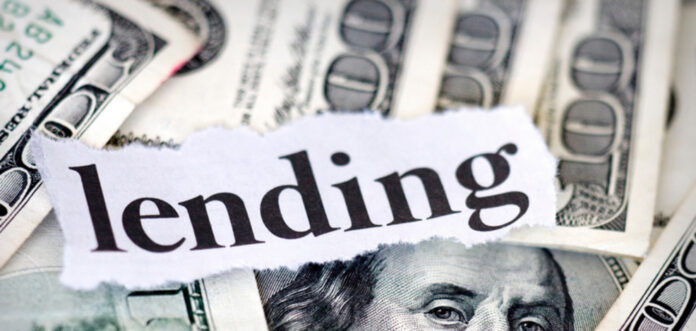Is it China?
Ghana’s debt crisis naturally shone the spotlight on the country’s biggest creditors.
At one point, China, as the country’s largest bilateral (country-to-country) creditor was seen as a potential stumbling block. But as a proportion of Ghana’s total debt or even foreign debt, China’s ~$1.7 billion or so in loans were not that substantial, even though its consent was certainly needed for the overall debt restructuring to proceed.
Surely, it is the IMF?
The IMF’s outsized role in the country’s fiscal crisis resolution is hard to miss, and some may thus assume that it is the country’s largest lender. It is not. Certainly, its $2.3 billion in outstanding loans to Ghana are significant, but that is hardly its main source of influence, which comes instead from issuing “stamps of approval” for the government’s policies.
The commercial creditors are big but in pieces.
Readers who are aware that the country’s stock of Eurobond debt forms the largest proportion of its foreign liabilities overall might wonder if a Eurobond investor is the largest creditor to Ghana. No. Eurobond investors, and other private-sector/commercial lenders in general, are a very diverse and fragmented bunch.
BlackRock is believed by some to be Ghana’s largest Eurobond investor. Yet, even at the peak of its holdings in 2020, it carried roughly $630 million. By May 2023, it was reporting just a little over $1 million in holdings of Ghanaian Eurobonds. It appears to have sold most of its holdings over time.
As of July 2024, Franklin Templeton held more than $30 million of Ghanaian government debt, a steep fall from the $1 billion portfolio it held just a few years ago. The strange thing about Franklin Templeton is that it plunged very deep into Ghana’s cedi debt on the domestic fixed-income market, not just Eurobonds. It has thus been hit by both massive currency depreciation as well as “mark to market” losses as Ghana’s bonds lost favour in the secondary markets. No investor in the world has been as battered by Ghana’s fiscal crisis as Franklin Templeton, the price of overconfidence.
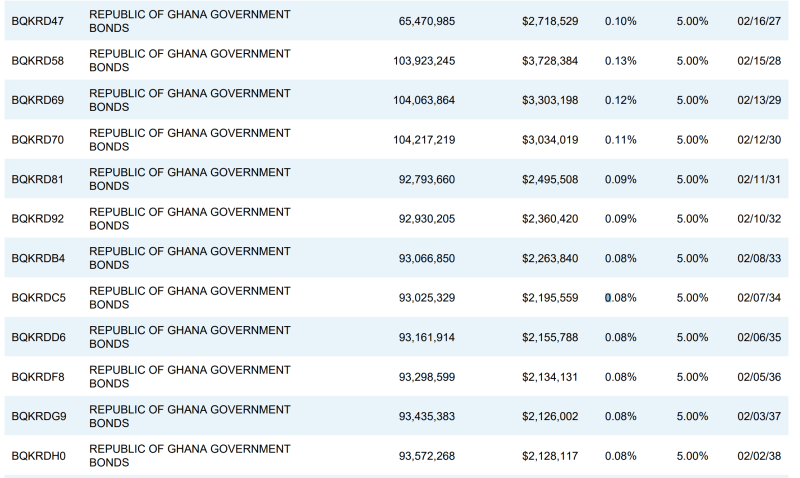
Ghana’s local banks and funds also hold government debt, both cedi- and forex-denominated. However, it is not one of these banks or funds that has the highest exposure to Ghana’s sovereign debt.
So, who then?
Who, then, is the largest lender in Ghana? Nominally speaking, it is the World Bank. Its overall commitment to the country is ~$3.9 billion (it has also lent to some regional facilities, of which Ghana is a beneficiary). However, due to various procedural matters, it takes quite a while for disbursements to flow. The actual funds lent, using the latest public records, is hence about $1.7 billion, lower than the IMF’s.
Very few Ghana watchers know that, as of last year, Deutsche Bank has risen through the ranks to join the likes of the World Bank, IMF, and China as an apex creditor to Ghana. Its roughly $3.5 billion infrastructure-heavy portfolio in Ghana appears to have seen more aggressive disbursements than those of the multilaterals like the World Bank, African Development Bank, and EBID.
Deutsche Bank’s lending commitment to Ghana is thus roughly double that of China and nearly equivalent to all the money Ghana has borrowed from countries richer than itself.
Mine, Deutsche Bank has been busy!
From funding the Kejetia market redevelopment (the largest such project in West Africa) and various roads to financing trauma hospitals and attempts to fix fast-growing Tamale’s water supply problems, Deutsche Bank’s bet on Ghana was once massive. Comparable to bets it is made in Angola, Morocco, and South Africa.
The German Bank only started to lend big to Ghana after the country started producing oil in 2010, though. Like a number of other commercial lenders exploring African opportunities with a new lens after the global financial crisis, Ghana’s combination of stability and commodity boom-driven growth was extremely attractive at the time.
What now after the default?
As the Ghanaian government turns its attention to restructuring its non-marketable commercial debt, essentially monies owed to international banks and other private creditors, the massive Deutsche Bank portfolio is a bulky reminder of the messy aftermath of the country’s default.
Very large parts of that portfolio are covered by rich government-owned political risk insurance entities, such as those in Sweden, the UK, and, tangentially, Brazil (a pan-African political risk insurer, ATIDI, also has a small exposure).
Because Deutsche Bank seeks to transfer its Ghana liabilities to these state-owned insurers, Ghana’s quest to close a debt restructuring agreement with the Paris Club of so-called “bilateral development partners” (basically, rich countries) has dragged out.
Whilst an Agreement in Principle was reached in January 2024, and the terms of an MOU finalised in June, it does not seem as if the actual signoff has been concluded. Once that is done, the country will need to close deals individually with the rich countries involved. Because of the credit insurance and guarantee issues, countries like the UK, Sweden, and China are insisting on painstaking detail on the exact mechanisms of any restructuring.
During previous debt relief programs like HIPC, Ghana was not as attractive to private creditors as it later became and, thus, political risk insurance did not have the consequence it has attained today.
Putting private financing of Ghana’s development in perspective
The so-called “development partners” – multilaterals like the World Bank and the IMF, rich countries, China, emerging powers like Saudi Arabia and Brazil, and major global foundations – have a much smaller budget collectively for global development than people think.
The money that a country like Ghana can borrow from such sources is a very small fraction of the investable capital in the world, theoretically speaking.
The flow of traditional global development money, often called “aid” or “development assistance”, is barely $220 billion a year. Meanwhile, global foreign direct investment, which is principally private sector driven, exceeds $1.3 trillion a year. Private market investment overall exceeds $24 trillion. In short, of the theoretical universe of investable capital, traditional development finance forms maybe 1%.
It follows, then, that for countries like Ghana to accelerate their development, they are going to need to excite private financiers, like Deutsche Bank. It is totally imperative given the current capital gaps. The country’s infrastructure financing deficit alone, till 2040, is more than $45 billion. That’s how much money Ghana needs to build enough roads, ports, power plants, sewage drains, etc. The UN has a slightly lower number of ~$38 billion, but only because it extends the horizon to 2047.
Yet, Ghana’s total foreign direct investment last year barely scratched $650 million. With loss of access to the international capital markets, the government’s ability to chip in has been ablated to almost nothing. All because Ghana has not been keeping its creditors and investors happy.
Why making international financiers happy in Ghana has been tough
One well-known problem in this regard is the country’s low efficiency of spending. The World Bank has long been interested in this topic, but so far not much seems to have changed on the ground.
How Ghana has thus far spent Deutsche Bank’s money is very illustrative of this challenge. For reason of space, we can look at two of the biggest items in the portfolio: Kejetia Market and a section of the Western Railway (between Takoradi and Huni Valley).
Kejetia Market
Of the ~$270 million approved for the market, reputedly West Africa’s largest, in 2015, Deutsche Bank accounts for almost $200 million, of which about $90 million is covered by guarantees (via risk insurance) provided by a UK government agency. A roughly similar amount was sought from Deutsche Bank and partners for phase two of the project in 2018.

Nearly 8250 small businesses, from grocers to fishmongers, were expected to benefit from phase one of the project. Phase two was expected to add over 172 square kilometers of additional business space to the complex, and support an extra 10,500 small businesses. The redevelopment effectively doubled the number of trading posts that could be accommodated in the area around the old, chaotic, market.
By the end of 2019, $3.8 million had been realised from leases to businesses accommodated in the phase one facility. The phase two expansion effort stalled due to right-of-access delays exacerbated in the wake of the pandemic, recommenced in 2022, then got paused during the debt crisis, and was only resuscitated this year.
So far, it has become amply clear that the project is a loss-maker. For two years running, the state owned electricity utility, ECG, has had to resort to cutting electricity to the entire market to get its bills paid. A failure to plan for individual metering of shops means that any such clampdown affects all traders, whether or not they are behind on their lease payments.
The municipal authorities of Kumasi also used a substantial portion of the market’s cash balance as security for a loan from a local lender, Fidelity Bank, to redevelop another market, which has itself become bogged down in construction delays and other issues. Future cashflow also appear to have been securitised in similar murky and opaque deals.
Furthermore, poor fire management has led to periodic outbreaks that have damaged significant sections of the facility. Low uptake of common area facilities has, moreover, stunted revenue potential, and the market currently cannot break even. Unsurprisingly, facility maintenance has degenerated.
To date, the market SPV has not been able to generate any reserves that can contribute to servicing the massive debt incurred in constructing the facility. The central government simply has to find the funds to pay off from somewhere else.
Western Railway
Ghana’s Western Railway line is a 339 kilometer stretch of rail mostly built during the colonial era.
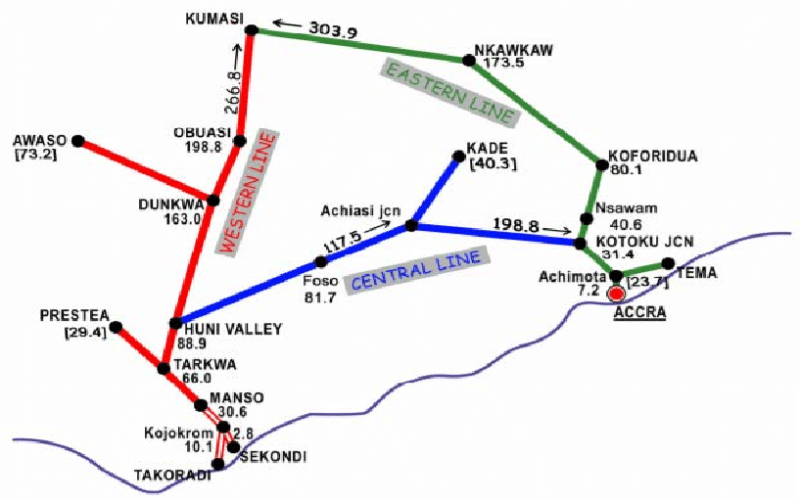
A hundred-kilometer stretch from the country’s principal export-focused port, Takoradi, to Huni Valley in the South-West is Deutsche Bank’s single largest financial exposure to Ghana since it was approved in 2021.
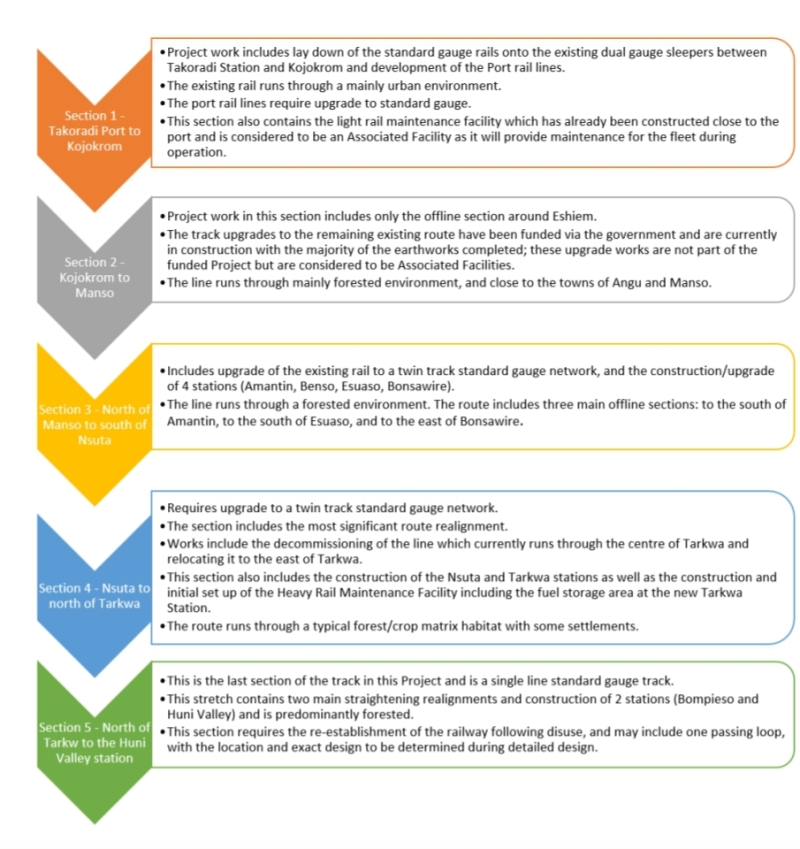
More than $660 million has been committed to the project by the German Bank, and insured for political risk mainly by Swedish government-owned entities, and secondarily by an equivalent agency in South Africa.
Deutsche Bank recognises the project as situated within a grander masterplan. It must also have realised that without effective execution of complementary infrastructure within the plan, the 100-km stretch by itself would be considerably underutilised.
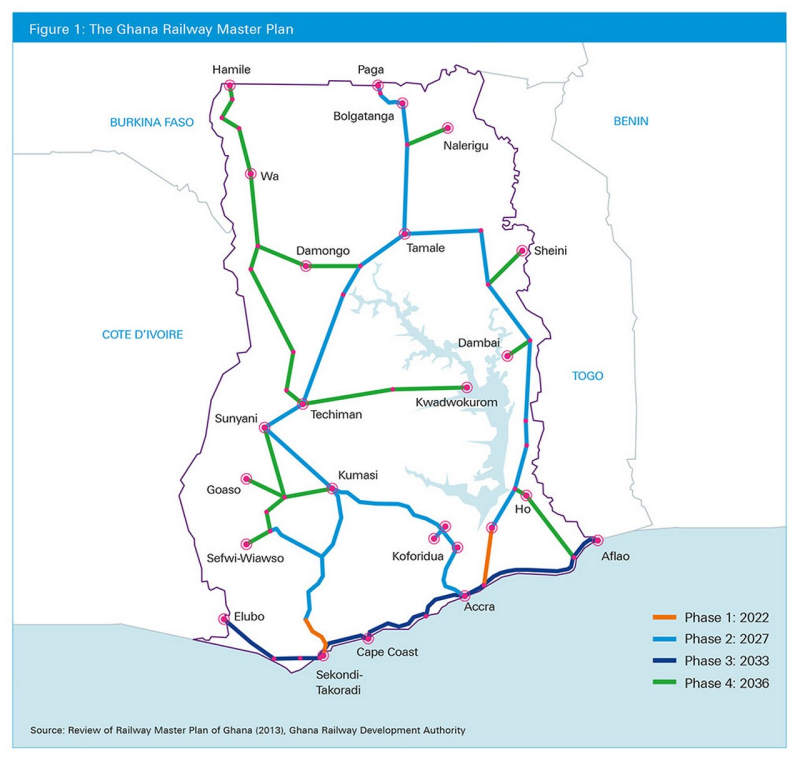
The bulk of the complementary components of the Western Line needed to fully exploit the Deutsche Bank – funded stretch was supposed to have been funded and built by a South African consortium, led by Thelo DB. In 2022, an agreement was finally inked to press forward with construction. Despite serious reservations in Ghana about the capacity of the consortium to deliver.
Thelo DB’s primary activity post-signing seems to be mainly in the department of issuing big announcements linking it to big projects across Africa and to big partners, like Deutsche Bahn, across the world.
Our probes show that the government’s lack of candour and seeming lack of straight-dealing scuttered an earlier plan for the much better known and financially better-grounded Transnet to move ahead with an earlier agreement. This was well before Transnet’s financial situation became untenable.
Should the complementary lines and infrastructure fail to come onstream, and cover at least the stretch to Dunkwa (with branch-lines to Awaso and Nyinahin), the 100km Takoradi to Huni Valley project would be seriously loss-making. Should the government somehow find the resources for rolling stock and to execute access infrastructure (for both the port feeder and the terminals) to serve customers, only the manganese mine at Nsuta is poised to come onboard in any meaningful way.
Nsuta can, however, only supply about 15% of the prospective medium-term optimal freight. Using the pricing per ton-km found in Ghana’s National Rail Masterplan, we can estimate freight revenue of about $24 million. The mines however expect pricing that should lead to revenues for the line operators of about $18 million, various factors considered.

At a generous 12% EBITDA margin, it would take decades before the operation can generate enough free cashflow to contribute meaningfully to paying off the loan.
One reason for this result is that the railway line is rather expensive, for a mostly rural affair. Using the Compass global cost guides as a benchmark, the rail line costs nearly thrice what one can get for an average high-speed rail in many parts of the world. Such high costs must be justified by solid revenue maximisation.
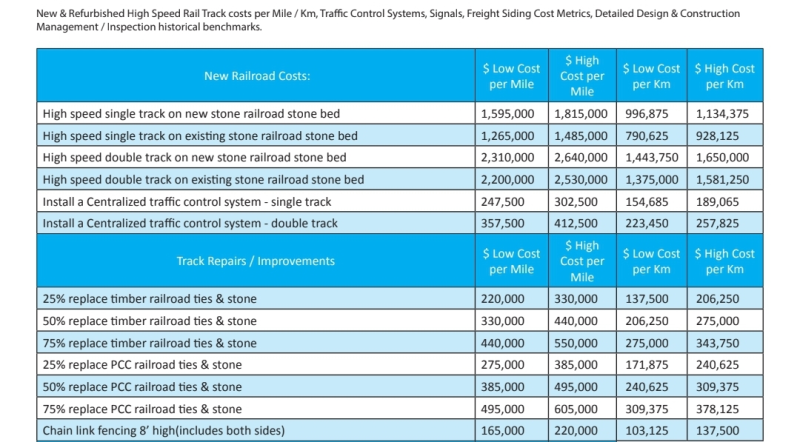
Conclusion
Summing up, it is clear that Ghana’s massive infrastructure gap does require the engagement of the likes of Deutsche Bank and other commercial/private sector funders willing to take the risk. However, without a considerable improvement in the government’s capacity to manage revenue-generating social infrastructure, there is a very high likelihood of bungling these projects and disappointing lenders.
The concern is not only with the returns realisable from such projects. Their suboptimal execution also leads to low multiplier effects on the rest of the economy. Without broad-based socio-economic growth being impacted positively by such projects, resulting in higher taxes and total factor productivity boosts, chronic sovereign debt defaults are inevitable.
Of course, private lenders learn from each others’ experiences so it is highly unlikely that the opportunities for chronic failure will continue into the future. Unless, somehow, Ghana discovers whatever Argentina has been drinking.
Source: IMANI Africa
READ ALSO:

